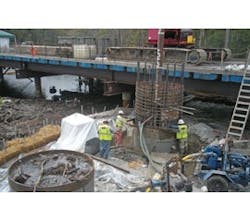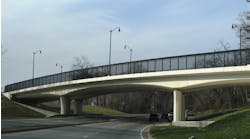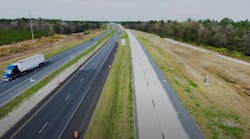Once a tree-eating monster is caught up in all of it’s glory, the best results are going to be produced when there is a place mat involved.
When the Army Corps of Engineers first scoured the proposed wetland-sensitive footprint of the Carolina Bays Parkway project in South Carolina, the primary concern was the level of disturbance such an undertaking would generate. The thought of huge machines clawing through the dense vegetation was too much to bear, so it was decided to keep the track lines as faint as possible—and the best way to do that was to require the use of mats.
“The entire project, it was either over or through designated wetlands, so we had to be very careful in our clearing,” Lou Hutcherson, project manager from Flatiron, told Roads & Bridges.
The only way through the thick landscape of trees and brush was with a one-of-a-kind excavator that had an appetite for mulching in place. R.E. Goodson, the subcontractor charged with clearing the area for the 7.5-mile, six-lane concrete roadway that will extend S.R. 31 from Rte. 544 over the Atlantic Intercoastal Waterway down to S.R. 707, hired a firm that specialized in the process calling for the use of a John Deere excavator with a rotary mower attachment. Mats are placed in front of the machine when it is ready to move forward; otherwise it is just sitting on the protective barrier while it goes about its feeding frenzy.
“It mulches [the trees] down to the stumps,” said Hutcherson.
Making a path
For tourists and South Carolina natives seeking recreation, the trek down to Myrtle Beach could be narrowed down to one primary obstacle: traffic signals. Red lights on S.R. 17 create backups, which turn a casual trip into one plagued with tension and anxiousness. The South Carolina DOT decided it was time to offer a route free of stop gaps, and the first phase of the Carolina Bays Extension Project was set in motion. Flatiron is now on phase three, which is scheduled to be complete in 2016. The first task is clearing the area and constructing the first of seven bridges, which is a 3,600-ft-long precast, prestressed concrete girder/plate steel girder bridge stretching across the Atlantic Intercoastal Waterway. Six more bridges and a 9-in.-thick concrete pavement will follow over the next two years.
At press time 100% of the clearing around the wetlands was complete, and 80% of the entire project was free of vegetation. A trestle that will be used to aid in bridge construction over the Atlantic Intercoastal Waterway also was nearing completion.
In all, 117 acres of thick forest had to be eliminated. The level of mulch produced had to be controlled. It was recommended that the amount did not exceed a thickness of
4 in., and in some areas the specialized excavator had to spread the chewed material rather tactfully in order to adhere to the Army Corps of Engineers’ request. In areas where the mulch was getting too deep, plants had to be pulled and hauled off site. There also were trees too tall for the excavator, and those also had to be trucked away. All of the work must be contained in an area marked with orange snow fence, and inside of that line was a double-row silt fence to keep any on-site water from entering the wetlands.
“The only thing that has been tricky for us is we bid this job in October [2013] and we did not get the award until February, and by the time we mobilized and were on-site building the trestle, it was May,” Tom Warren, senior project manager, Civil Division, for Flatiron told Roads & Bridges. “So we lost three months out of that window and had to accelerate trestle construction.”
The need for speed was due to a moratorium on sturgeon in the Atlantic Intercoastal Waterway from January to April, which meant Flatiron had to be out of the water by the first day of 2015. Double shifts were executed to make up the time.
“We have worked diligently to place the drilled shafts on the north side of the Intercoastal and worked very diligently to get the bridge access trestle in on the south side so we can make sure we get our casings for those particular drilled shafts in the water before the Jan. 1 deadline,” said Hutcherson. “As long as we have the casings in the ground we can work within the casings, and it is not considered in the water.”
The 3,600-ft-long, 117-ft-wide bridge calls for a total of 108 columns each 6 ft in diameter. Each bent in the trestle contains four columns. Twenty-three bents will have four 7-ft-diam. drilled shafts placed 40 to 75 ft deep in the water, and four bents will have six 8.5-ft-diam. drilled shafts about 85 ft deep.
Drilled-shaft installation also is covered in environmental restrictions. Plastic sheeting, hay bales and special steel “doughnuts” that go around the casings are there to catch any excavated material during the drilling process. Everything pulled needs to be hauled away because there is no stockpiling allowed on the jobsite. According to Hutcherson, half of the drilled shafts were in place and about a third of the cast-in-place columns were constructed in mid-December. Caps also were being set, and the goal was to start setting steel beams in mid-January.
Of the remaining bridges yet to be constructed, four will be 60-ft spans across wetlands and the other two require settlement time. The 220-ft-long Enterprise Road overpass calls for a 270-day secondary road closure where Flatiron will place fill and wait 45 days for it to settle before beginning construction. A 148-ft-long bridge over S.R. 707 comes with a 90-day settlement period.
Removing the fizz
Tropical Soda Apple settled in the South some time ago, and it was imported to South Carolina for slope stabilization. The plant, however, has grown out of control and livestock refuse to eat it. A seed dropped in those areas may require a rancher to relocate, and a single seed has a 30-year germination lifecycle. The Carolina Bays Extension project sits in a Tropical Soda Apple breeding ground, so Flatiron has set up a wash plant on the north end of the job. Any vehicle or piece of equipment exiting the jobsite must have its wheels cleaned by a power washer.
“South Carolina wants to confine it to where it already exists,” said Hutcherson. “All the person at the wash plant does is wash tires all day. We need to make sure the seeds do not germinate someplace else.”
It’s virtually impossible to keep venomous snakes in one place. Rattlesnakes, copperheads and water moccasins also roam the site, and some have preferred the snug quarters underneath the required mats.
“We saw a 6-ft rattler the other day. You just have to be on the lookout. You have to be mindful of where you are and what could be there,” said Hutcherson.
Unfortunately, some people do not care if they overstep their bounds. According to Warren, vandalism has been an issue. During the first weekend Flatiron was on-site, somebody decided to take a few pieces of equipment for a joyride and rolled them over. Over the Thanksgiving weekend another individual fired a shotgun at a crane.
“It’s almost considered a rural area, so it’s easy to be mischievous,” added Warren. R&B



